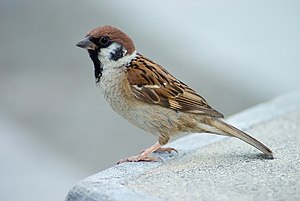Since the first appearance of the highly pathogenic avian influenza H5N1 virus in 1997, over 500 human cases have been reported--more than 60% of which resulted in death. Researchers are still trying to work out the many possible routes of disease transmission in order to decrease human exposure to the virus. This is not an easy task given how many wild and domestic birds may be carriers, and the variety of ways in which these animals may come into contact with both each other and the humans they can ultimately infect.
A recent study out of Cambodia highlights one unusual potential source of viral spread: the practice of "animal release," whereby Buddhists seeking to improve their karma purchase caged birds, kiss them, and then set them free. Buddhism is practiced by a high proportion of residents in the highly H5N1-affected region of Southeast Asia, which means that this practice could potentially place hundreds of millions of people at risk of infection. One common "merit release bird" is the Eurasian tree sparrow (Passer montanus), which was the focus of the current study. Collaborators from the Institut Pasteur in Cambodia, the Cambodian Ministry of Agriculture Forestry and Fisheries, and the University of Hong Kong purchased 35 of these birds from Buddhist pagodas around Phnom Penh in order to investigate three potential transmission routes: sparrow-to-sparrow, sparrow-to-chicken, and duck-to-sparrow.
(Eurasian tree sparrow, Passer montanus)
The researchers first determined mean lethal dose for sparrows in order to find out how "bad" an H5N1 infection needs to be before it kills a sick animal; they also observed signs and symptoms displayed by infected individuals and measured the length of time it took for sick birds to die. When exposed to other sparrows and chickens, infected sparrows were either allowed to fly freely and utilize a perch above their cage-mates (as they would in nature), or were constrained in a smaller cage and placed near the other birds (mimicking captivity conditions in Buddhist pagodas); only the "natural" caging condition was used when the sparrows were exposed to infected ducks. A variety of laboratory tests were then conducted to assay for disease transmission between focal pairs. The researchers also collected feather samples from sick sparrows in order to see whether the birds carried external contamination that might be transmissable to humans handling and kissing them during releases.
When birds were directly inoculated with H5N1, they were highly susceptible to infection, but their responses to the virus varied widely. Chickens, for instance, died very quickly. Ducks took about twice as long to die and displayed obvious neurological signs of infection. Like ducks, sparrows died approximately 4 days after infection, but showed only mild clinical signs of the disease. Thus, humans handling sick sparrows--during capture, sale, or release--might have no idea they are in contact with an ill animal.
(Domestic duck)
H5N1-inoculated sparrows did not, under any caging condition, transfer infection to other sparrows; nor did sparrows infect chickens when they were allowed to fly freely around the cage. However, when sparrows were confined to cages within the experimental enclosure, they were in much closer contact with the chickens, who frequently pecked at the sparrows through the bars. As a result, all chickens exposed under these conditions eventually died from the H5N1 virus. When exposed to sick ducks, sparrows fared slightly better: Two-thirds of the songbirds became ill, but only 50% of these cases were fatal. Of the 50 sparrows tested for H5N1 particles on their feathers, approximately half were positive, indicating that handling--and kissing--of these birds could expose humans to H5N1 infection.
The good news is that sparrows caged together in Buddhist pagodas are unlikely to spread H5N1 to each other; further, only under some caging circumstances are they likely to pass the virus on to chickens. Thus, in domestic or market situations when both species of bird may be in close quarters, humans can prevent viral exchange by keeping caged sparrows well away from the dangerous beaks of hungry or inquisitive chickens. The bad news is that chickens can be infected by sparrows, something that is particularly likely to happen when/if chickens nibble on infected sparrow carcasses encountered on the ground--a not unlikely circumstance given chickens' "propensity for pica." In fact, this particular mode of transmission may be problematic for any scavenging or carnivorous bird species.
(Chickens, Gallus domesticus)
Another piece of bad news is the finding that sparrows can become infected via exposure to H5N1-carrying ducks. Ducks have earned a reputation for causing the "silent spread" of some viruses, which means that humans may not realize when their domestic stocks have become contaminated. Since sparrows often come into close contact with humans and livestock, and since bird hunters may be particularly likely to capture sparrows near human establishments, it is possible--if not probable--that this poultry-to-sparrow transmission route could pose a threat to humans during H5N1 outbreaks. In fact, the researchers found that duck-exposed sparrows often survived for over a week before succumbing to their infection, meaning that sick birds could easily travel from one farm to another, be transported for religious practices, and/or have repeated contact with humans while carrying the infection.
However, although a recent study in Indonesia found genetic similarities between H5N1 viruses carried by humans and a single infected tree sparrow, there has not yet been a confirmed case of sparrow-to-human transmission. Thus, as far as the researchers know, it is a threat that we should be aware of, but not yet one to panic over.
---
Gutiérrez, R.A., Sorn, S., Nicholls, J.M., and Buchy, P. Eurasian tree sparrows, risk for H5N1 virusspread and contamination through Buddhist ritual: an experimental approach. PLoS ONE: 6(12):e28609.
Thanks to the following websites for providing the images used in this post:
http://en.wikipedia.org/wiki/Eurasian_Tree_Sparrow
http://duckexpert.wordpress.com/page/2/
http://www.animallaw.info/topics/tabbed%20topic%20page/spuschickens.htm


No comments:
Post a Comment